Excavation Method Determination of Earth-Retaining Wall for Sustainable Environment and Economy: Life Cycle Assessment Based on Construction Cases in Korea
Abstract
1. Introduction
2. Theoretical Review of LCA Technique
2.1. Concept of LCA Technique
2.2. Application of LCA in the Construction Industry
2.3. Application of Similar Techniques for the Selection of Construction Methods on Civil Engineering Structures
3. Selection of Cases and Stability Review for LCA of Earth-Retaining Wall
3.1. Evaluation of Case Selection and Soil Characteristics
3.2. Evaluation of Stability in Each Case
4. Analysis of LCA on Earth-Retaining Wall
4.1. Method and Scope of the Evaluation of Environmental Impact Assessment
4.2. LCA Results of the Earth-Retaining Wall According to Excavation Depth
4.2.1. Evaluation Results of Environment Load
4.2.2. Evaluation Results of Environment Cost
4.3. Relationship between Excavation Depth, Total Environmental Load, and Total Environmental Cost by Soil Condition
5. Conclusions
- If a calculation is conducted after calculating the environmental load by list analysis of the construction stage, this affects the selection of the construction method for the earth-retaining wall, so it is possible to select an optimal construction method for an earth-retaining wall considering stability and economic feasibility in various soil conditions via selection of a construction method that considers environmental loads in line with international trends.
- Evaluation of the stability of the earth-retaining wall revealed that the C.I.P construction method was the best in terms of stability in both composite soil and sandy soil in the case of a shallow excavation. In terms of stability in the case of deep excavation, the S.C.W construction method was the best in composite soil and the C.I.P construction method was the best in sandy soil. In soft clay soil, the deeper the excavation depth, the greater the safety factor.
- Evaluation of the environmental load of construction methods for the earth-retaining wall revealed that the H-Pile+Earth Plate construction method had low economic feasibility compared to the other construction methods because the environmental load of the H-Pile+Earth Plate method increased due to an increase in ecotoxicity. Furthermore, at the same excavation depth, the environmental load characteristics had a greater effect on the selection of construction methods in sandy soil than in composite soil.
- Evaluation of the environmental costs of the construction methods for the earth-retaining wall revealed that the deeper the excavation depth, the greater the environmental cost. For a shallow excavation, in both composite and sandy soil, the H-Pile+Earth Plate construction method had low economic feasibility with the highest environmental cost, and the same is true for a deep excavation. In the case of soft clay soil, the environmental cost of the Sheet Pile construction method was higher than in other soil conditions, and the environmental cost was higher in sandy soil than in composite soil.
Author Contributions
Funding
Institutional Review Board Statement
Informed Consent Statement
Data Availability Statement
Conflicts of Interest
References
- ISO. ISO 14040: 2006-Environmental Management, Life Cycle Assessment, Principles and Framework; International Organization for Standardization: Geneva, Switzerland, 2006. [Google Scholar]
- ISO. ISO 14044: 2006-Environmental Management, Life Cycle Assessment, Requirement sand Guidelines; International Organization for Standardization: Geneva, Switzerland, 2006. [Google Scholar]
- Guggemos, A.A.; Horvath, A. Comparison of Environmental Effects of Steel- and Concrete-Framed Buildings. J. Infrastruct. Syst. 2005, 11, 93–101. [Google Scholar] [CrossRef]
- Keoleian, G.A.; Kendall, A.; Dettling, J.E.; Vanessa, M.S.; Richard, F.C.; Michael, D.L.; Victor, C.L. Life cycle modeling of concrete bridge design: Comparison of engineered cementitious composite link slabs and conventional steel expansion joints. J. Infrastruct. Syst. 2005, 11, 51–60. [Google Scholar] [CrossRef]
- Araújo, J.P.C.; Oliveira, J.R.M.; Silva, H.M.R.D. The importance of the use phase on the LCA of environmentally friendly solutions for asphalt road pavements. Transp. Res. Part D Transp. Environ. 2014, 32, 97–110. [Google Scholar] [CrossRef]
- Society of Environmental Toxicology and Chemistry (SETAC). Guidelines for Life-Cycle Assessment: A “Code of Practice”; SETAC Publications: Pensacola, FL, USA, 1993. [Google Scholar]
- China National Institute of Standardization. GB/T 24040-2008 Environmental Management-Life Cycle Assessment-Principle and Framework; Standard Press of China: Beijing, China, 2008. [Google Scholar]
- Hui, M.; Zhigang, Z.; Xia, Z.; Shuang, W. A Comparative Life Cycle Assessment (LCA) of Warm Mix Asphalt (WMA) and Hot Mix Asphalt (HMA) Pavement: A Case Study in China. Adv. Civ. Eng. 2019, 19, 9391857. [Google Scholar]
- Guggemos, A.A. Environmental Impacts of On-Site Construction Processes: Focus on Structural Frames. Ph.D. Thesis, University of California, Berkeley, CA, USA, 2003. [Google Scholar]
- Guggemos, A.A.; Horvath, A. Decision-support tool for assessing the environmental effects of constructing commercial buildings. J. Arch. Eng. 2006, 12, 187–195. [Google Scholar] [CrossRef]
- Lee, J.H. A Study on GHG Emissions and Mitigation Potentials of the Industrial Sector in Korea. Master’s Thesis, Keimyung University, Daegu, Korea, 2010. [Google Scholar]
- Mao, C.; Shen, Q.; Shen, L.; Tang, L. Comparative study of greenhouse gas emissions between off-site prefabrication and conventional construction methods: Two case studies of residential projects. Energy Build. 2013, 66, 165–176. [Google Scholar] [CrossRef]
- Hong, J.; Shen, G.Q.; Feng, Y.; Lau, W.S.T.; Mao, C. Greenhouse gas emissions during the construction phase of a building: A case study in China. J. Clean. Prod. 2015, 103, 249–259. [Google Scholar] [CrossRef]
- Luo, W.; Sandanayake, M.; Zhang, G. Direct and indirect carbon emissions in foundation construction—Two case studies of driven precast and cast-in-situ piles. J. Clean. Prod. 2019, 211, 1517–1526. [Google Scholar] [CrossRef]
- Frey, H.C.; Rasdorf, W.; Lewis, P. Comprehensive field study of fuel use and emissions of nonroad diesel construction equipment. Transp. Res. Rec. J. Transp. Res. Board 2010, 2158, 69–76. [Google Scholar] [CrossRef]
- Lewis, P. Estimating Fuel Use and Emission Rates of Nonroad Diesel Construction Equipment Performing Representative Duty Cycles. Ph.D. Thesis, North Carolina State University, Raleigh, NC, USA, 2009. [Google Scholar]
- Lewis, P.; Frey, H.C.; Rasdorf, W. Development and use of emissions inventories for construction vehicles. Transp. Res. Rec. J. Transp. Res. Board 2009, 2123, 46–53. [Google Scholar] [CrossRef]
- Junnila, S.; Horvath, A.; Guggemos, A.A. Life-Cycle Assessment of Office Buildings in Europe and the United States. J. Infrastruct. Syst. 2006, 12, 10–17. [Google Scholar] [CrossRef]
- Sandanayake, M.; Zhang, G.; Setunge, S. Environmental emissions at foundation construction stage of buildings—Two case studies. Build. Environ. 2016, 95, 189–198. [Google Scholar] [CrossRef]
- Zhang, G.; Sandanayake, M.; Setunge, S.; Li, C.; Fang, J. Selection of emission factor standards for estimating emissions from diesel construction equipment in building construction in the Australian context. J. Environ. Manag. 2017, 187, 527–536. [Google Scholar] [CrossRef]
- Sandanayake, M.; Zhang, G.; Setunge, S.; Luo, W. Estimation and comparison of environmental emissions and impacts at foundation and structure construction stages of a building—A case study. J. Clean. Prod. 2017, 151, 319–329. [Google Scholar] [CrossRef]
- Sandanayake, M.; Zhang, G.; Setunge, S. A comparative method of air emission impact assessment for building construction activities. Environ. Impact Assess. Rev. 2018, 68, 1–9. [Google Scholar] [CrossRef]
- Santero, N.J. Pavements and the Environment: A Life-Cycle Assessment Approach. Ph.D. Thesis, University of California Berkeley, Berkeley, CA, USA, 2009. Unpublished work. [Google Scholar]
- Bjarne, S.; Jeppe, C.D. CO2 emission reduction by exploitation of rolling resistance modelling of pavements. Procedia Soc. Behav. Sci. 2012, 48, 311–320. [Google Scholar]
- Shang, C.; Zhang, Z.; Li, X. Research on energy consumption and emission of life cycle of expressway. J. Highway Transp. Res. Dev. 2010, 27, 149–154. [Google Scholar]
- Ministry of Land, Infrastructure and Transport of Republic of Korea. Environmental Load Reduction Type LCA (Life Cycle Assessment) Based Design and Construction Technology Development; Construction & Transportation R&D Report; Ministry of Land, Infrastructure and Transport: Sejong, Korea, 2017.
- Lee, Y.K.; Han, J.G.; Kwon, S.H. A Study on the Evaluation of Environmental Load Based on LCA Using BIM—Focused on the Case of NATM Tunnel. J. Korean Soc. Civil Eng. 2018, 38, 477–485. [Google Scholar]
- Häkkinen, T.; Mäkelä, K. Environmental Adaption of Concrete: Environmental Impact of Concrete and Asphalt Pavements; VTT Technical Research Centre of Finland: Espoo, Finland, 1996. [Google Scholar]
- Han, I.X.; Zhow, W.; Tang, L.C.M. Model-based life cycle cost and assessment tool for sustainable building design decision. In Proceedings of the 4th International Conference on Construction Engineering and Project Management (ICCEPM-20011), Sydney, Australia, 16–18 February 2011. [Google Scholar]
- Kwon, S.H. Development of Assessment Model for Environmental Economics of Construction Projects. Ph.D. Thesis, Chung-Ang University, Seoul, Korea, 2008. [Google Scholar]
- Bae, C.H. A Study on the Selection of Retaining Wall System for the Underground. Master’s Thesis, Chonnam National University, Gwangju, Korea, 2010. [Google Scholar]
- Han, J.G.; Lee, J.Y. Case Study on AHP Technique Application for the Reinforcing Method Selection on a Cut-Slope. J. Korean Geotech. Soc. 2008, 24, 81–88. [Google Scholar]
- Lee, H.C.; Woo, S.K.; Kim, O.K. Development of Decision Making Model for Selecting the Soft Foundation Improvement Method Using AHP technique. J. Korean Soc. Civ. Eng. 2007, 27, 499–506. [Google Scholar]
- Lee, C.H.; Jeong, K.C. An Analytic Hierarchy Process based Decision Support System for Selecting Foundation Practice. Korean J. Constr. Eng. Manag. 2012, 13, 129–139. [Google Scholar] [CrossRef][Green Version]
- Pan, N.F. Fuzzy AHP approach for selecting the suitable bridge construction method. Autom. Constr. 2008, 17, 958–965. [Google Scholar] [CrossRef]
- Ebrahimian, A.; Ardeshir, A.; Radb, I.Z.; Ghodsypour, S.H. Urban stormwater construction method selection using a hybrid multi-criteria approach. Autom. Constr. 2015, 58, 118–128. [Google Scholar] [CrossRef]
- Shen, L.; Yan, H.; Fan, H.; Wu, Y.; Zhang, Y. An integrated system of text mining technique and case-based reasoning (TM-CBR) for supporting green building design. Build. Environ. 2017, 124, 388–401. [Google Scholar] [CrossRef]
- Lorenz, T.; Jost, A. Towards an orientation framework in multi-paradigm modelling: Aligning purpose, object and methodology in System Dynamics, Agent-based Modeling and Discrete-Event-Simulation. In Proceedings of the 24th International Conference of the System Dynamics Society, Nijmegen, The Netherlands, 23–27 July 2006; pp. 2134–2151. [Google Scholar]
- Tsai, W.H.; Lin, S.J.; Lee, Y.F.; Chang, Y.C.; Hsu, J.L. Construction method selection for green building projects to improve environmental sustainability by using an MCDM approach. J. Environ. Plan. Manag. 2013, 56, 1487–1510. [Google Scholar] [CrossRef]
- Kim, J.Y.; Park, W.Y.; Kang, K.I. A Study on the Selection System of Retaining Wall Methods Using Neural Network. J. Archit. Inst. Korea Struct. Constr. 2002, 18, 69–76. [Google Scholar]
- Yau, N.J.; Yang, J.B. Applying case-based reasoning technique to retaining wall selection. Autom. Constr. 1998, 7, 271–283. [Google Scholar] [CrossRef]
- Park, J.K.; Jun, S.K.; Kim, Y.K.; Heo, E.N. A study on the improvement in decision making analysis for the selection of tunnel construction method. J. Korean Tunnel Undergr. Space Assoc. 2002, 4, 261–276. [Google Scholar]
- Ministry of Land, Infrastructure and Transport. KDS 21 30 00: 2016, Korean Design Standard; Ministry of Land, Infrastructure and Transport: Sejong, Korea, 2016.
- Caspe, M.S. Surface settlement adjacent to braced open cut. J. Soil Mech. Found. Div. 1966, 92, 51–59. [Google Scholar] [CrossRef]
- Bowles, J.E. Foundation Design and Analysis, 4th ed.; McGraw-Hill Book Company Limited: Maidenhead, UK, 1988; pp. 658–661. [Google Scholar]
- Ministry of Land, Infrastructure and Transport of Republic of Korea. Standard of Construction Estimate; Ministry of Land, Infrastructure and Transport: Sejong, Korea, 2017.
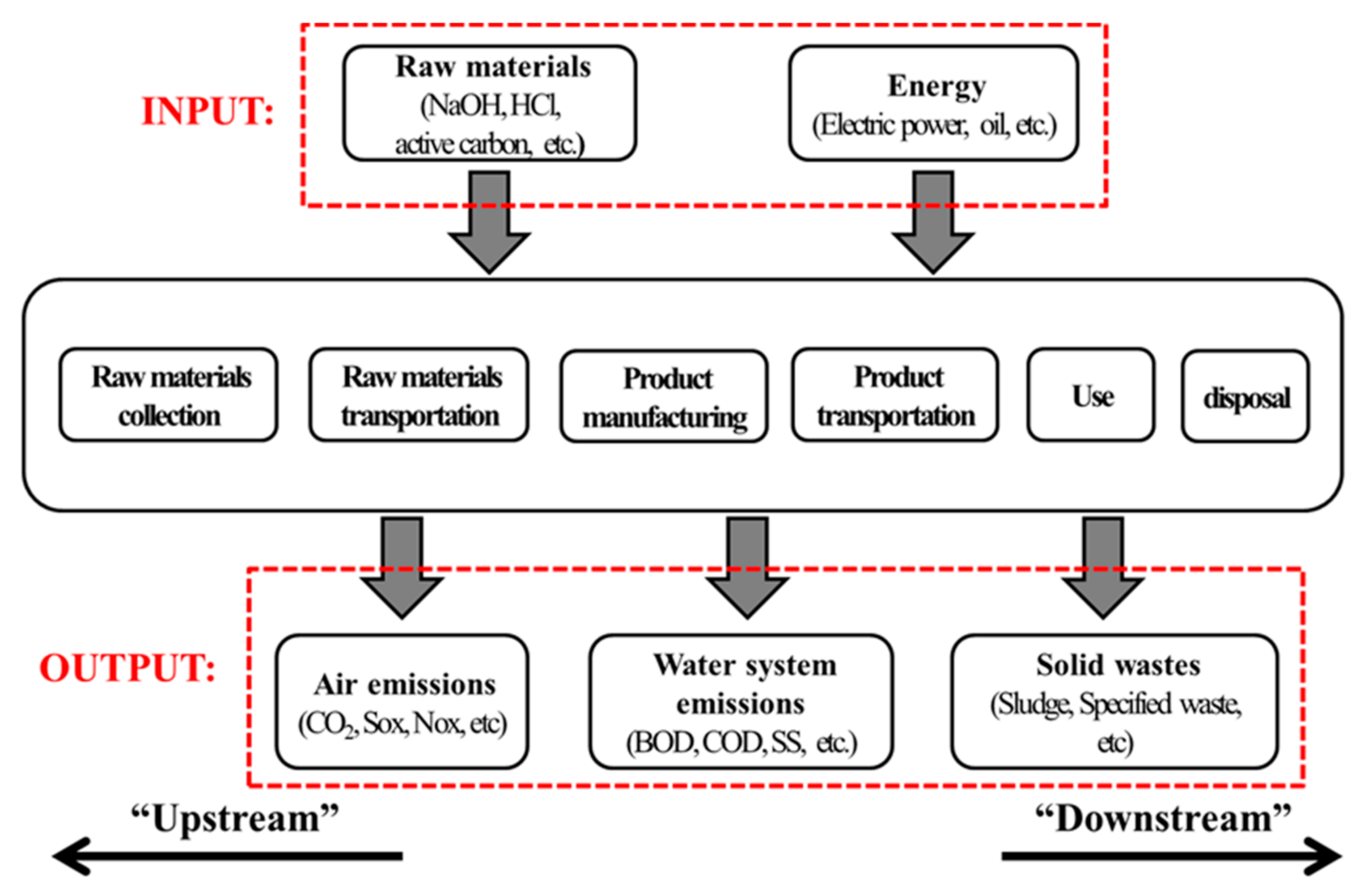
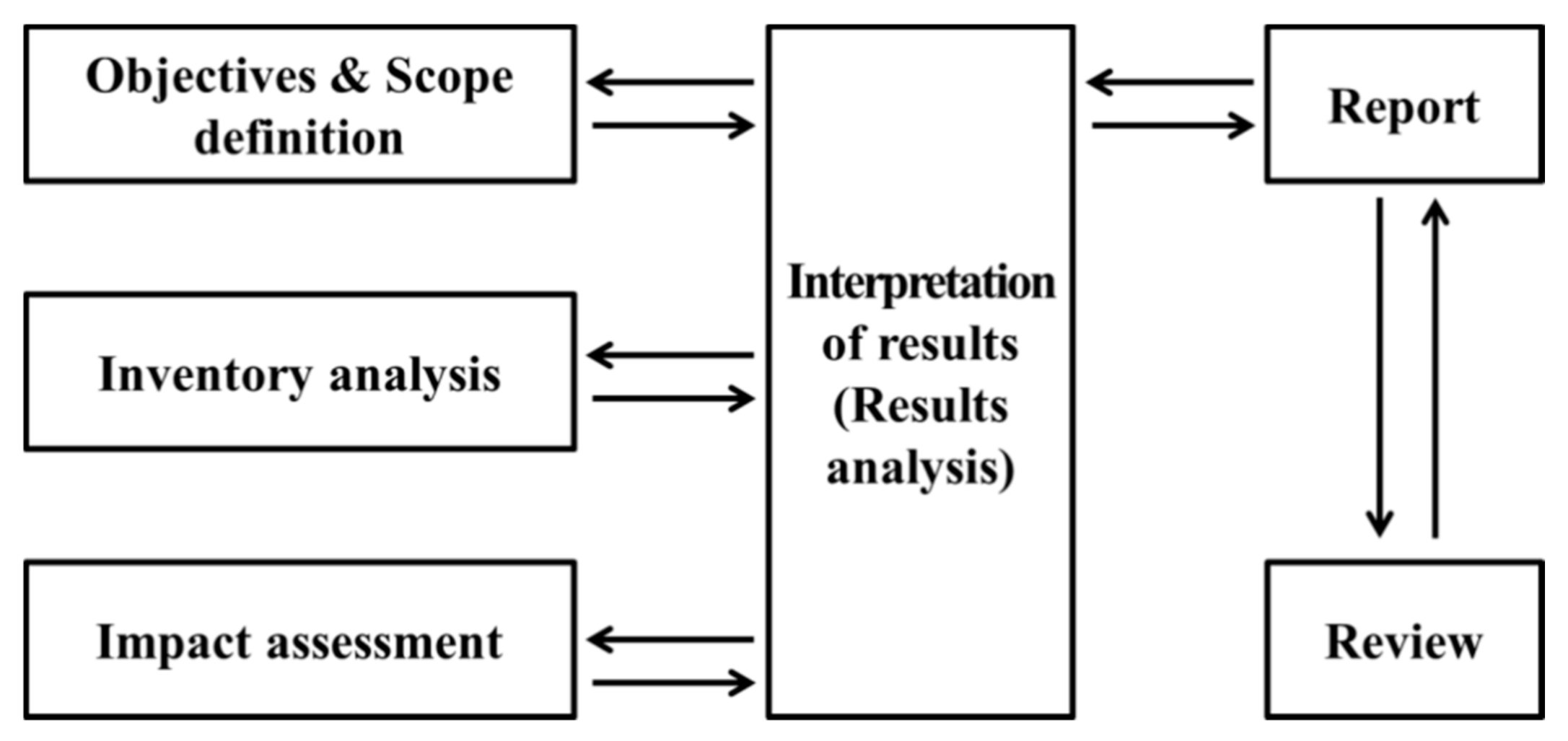
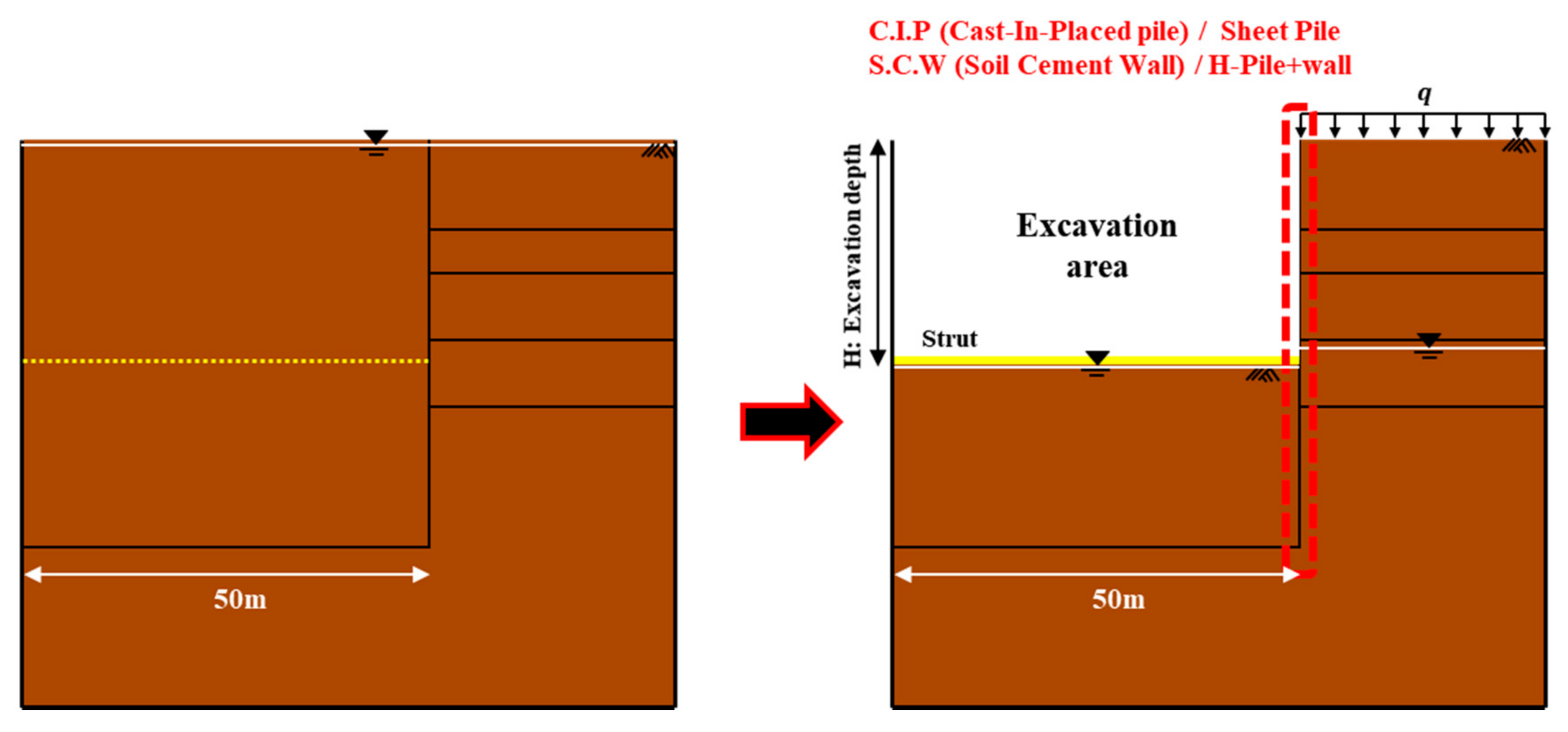
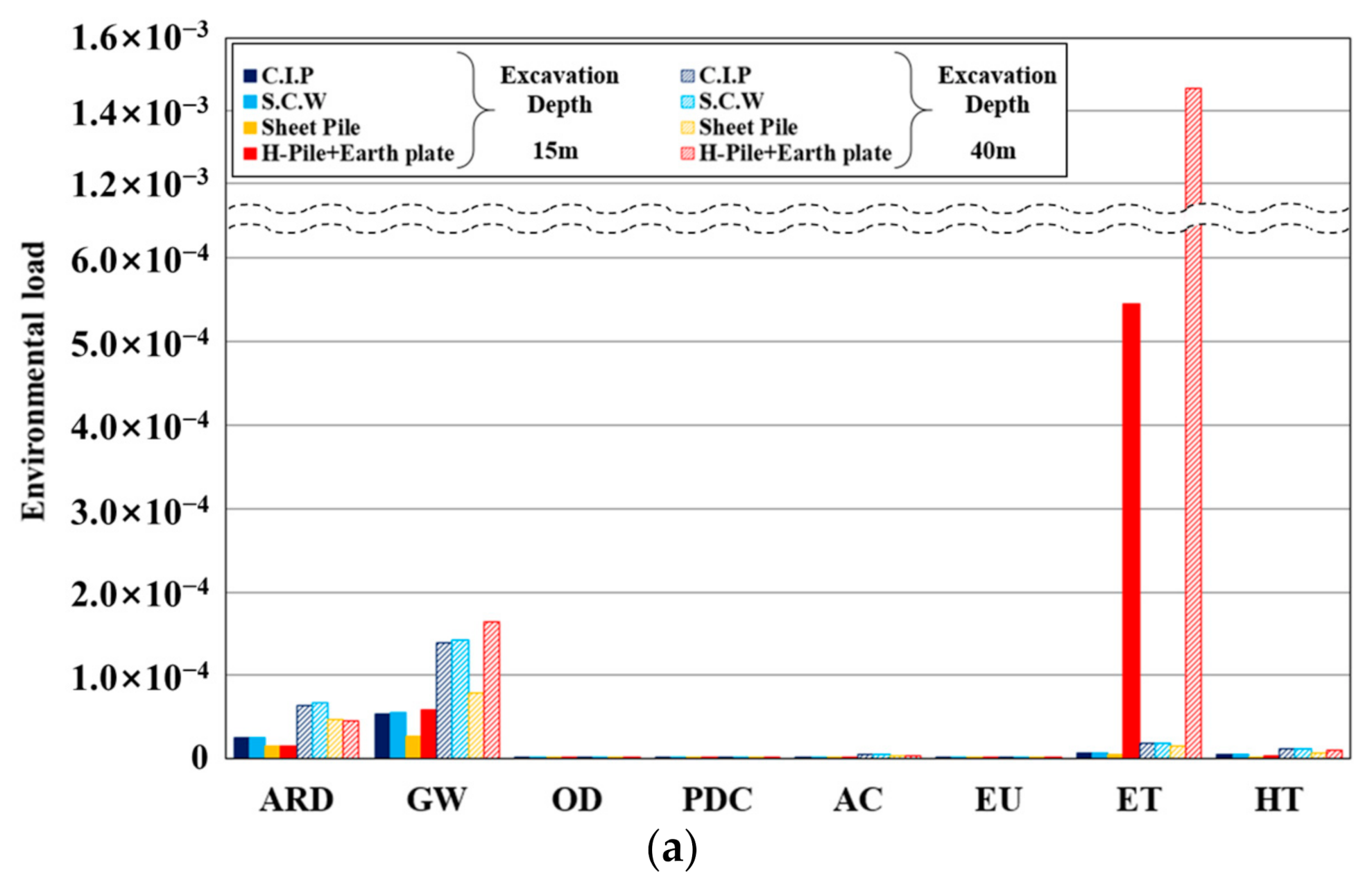
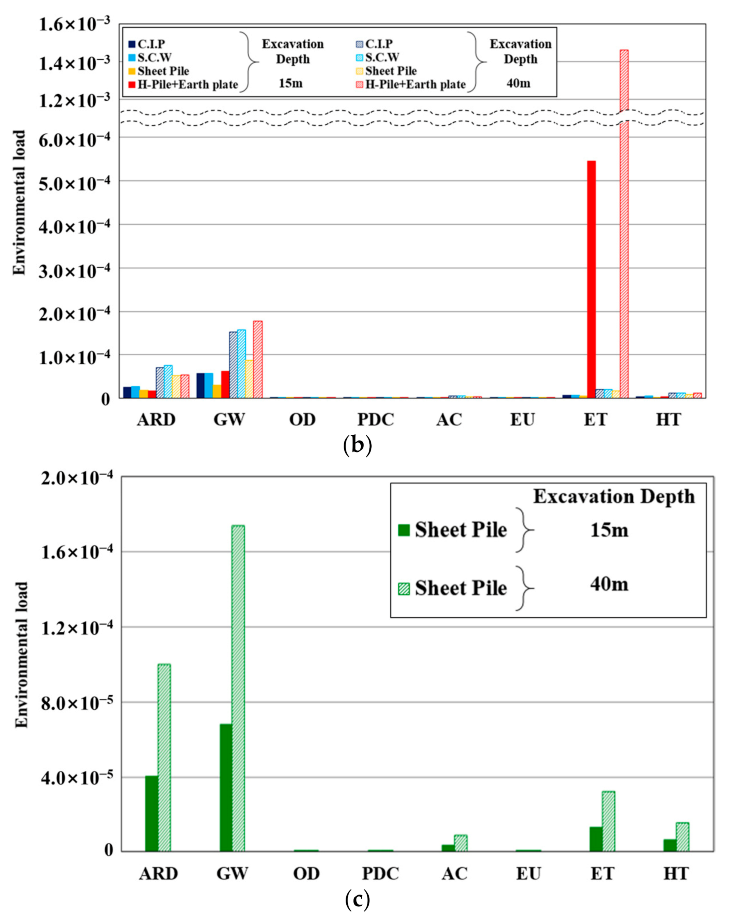
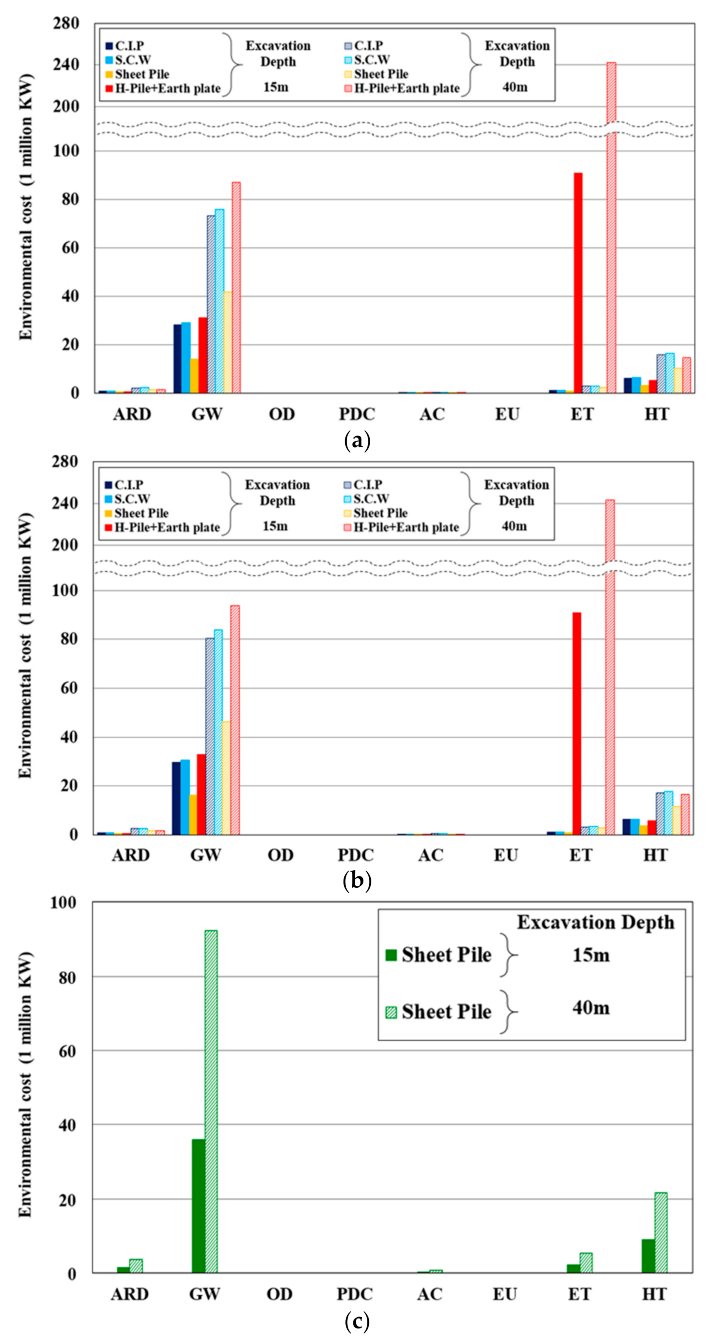
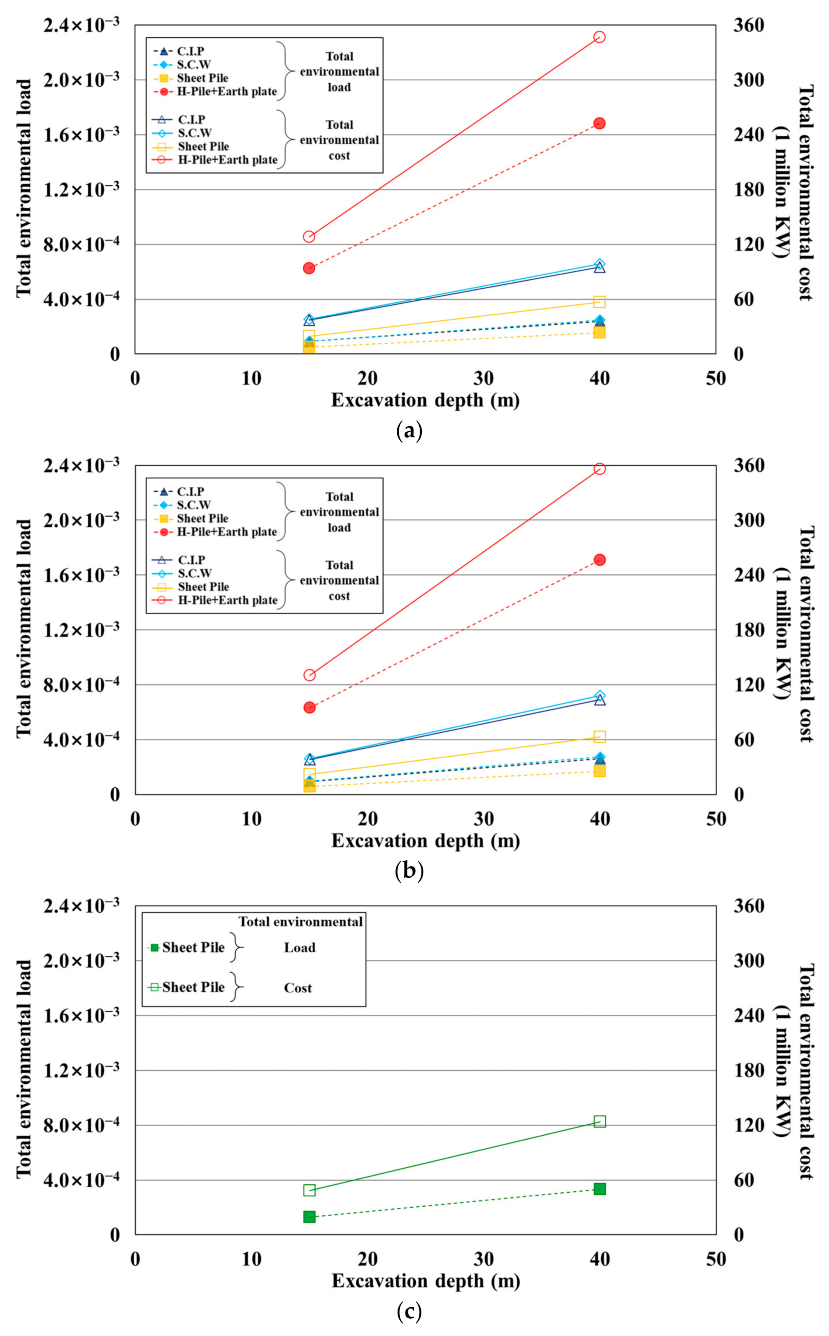
| Country | Purpose | Project Contents | Research (Managing) Institute |
|---|---|---|---|
| The United States | Decision support for purchasing construction materials with excellent environmental economic feasibility. Developed as part of the US EPA (Environmental Protection Agency) Green Purchasing Program. | Standardize both the LCA as an environmental performance evaluation tool and the LCC as an economic feasibility evaluation tools into ASTM (American Society for Testing and Materials). Development of a methodology and software called BEES (Building for Environmental and Economic Sustainability) to integrate and make a decision. | NIST (National Institute of Standards and Technology) of the United States |
| Finland | Finding ways to convert construction materials, construction, and construction waste treatment in civil infrastructure projects such as road construction in an environmentally friendly manner. | LCI DB (Life Cycle Inventory DataBase) construction for construction industry. LCA implementation for various construction scenarios. Comparative evaluation by scenario. | Road Corporation VTT |
| Sweden | Identifying the significance of road maintenance from an LCA perspective. | Identification of environmental impacts throughout the entire process of road construction, maintenance, and disposal, and support of various decision-making processes. | Road Corporation IVL |
| Netherlands | Identifying environmental impacts on national infrastructure industries, such as sewage facilities, through LCA techniques. | Identifying environmental performance through LCA techniques in constructing various national infrastructures. Support for environmentally friendly design. | Concrete Association Cement Association INTRON BRE |
| England | Building material certification program | Quantifying the environmental performance of construction materials using LCA techniques. | BRE certification authority |
| Australia | Transitioning to an environmentally friendly construction industry using LCA technique. | Identifying opportunities for environmental improvement for construction materials and systems through performing LCA. | Ministry of Environment RMIT (Royal Melbourne Institute of Technology) |
| Japan | Increasing the Recycling Rate of Construction Waste. | Identification of carbon dioxide (CO2) throughout the entire process of the construction industry | KAJIMA Construction Company |
| No | Excavation Area (m2) | Excavation Depth (m) | Soil Conditions | Construction Method for Earth Retaining Wall |
|---|---|---|---|---|
| Case 01 | 50 m × 50 m (Medium-Scale) | 15 (Shallow Excavation) | Composite Soil | C.I.P (Cast-In-Placed pile) |
| Case 02 | S.C.W (Soil Cement Wall) | |||
| Case 03 | Sheet Pile | |||
| Case 04 | H-Pile+Earth Plate | |||
| Case 05 | Sandy Soil | C.I.P (Cast-In-Placed pile) | ||
| Case 06 | S.C.W (Soil Cement Wall) | |||
| Case 07 | Sheet Pile | |||
| Case 08 | H-Pile + Earth Plate | |||
| Case 09 | Soft Clay Soil | Sheet Pile | ||
| Case 10 | 40 (Deep Excavation) | Composite Soil | C.I.P (Cast-In-Placed pile) | |
| Case 11 | S.C.W (Soil Cement Wall) | |||
| Case 12 | Sheet Pile | |||
| Case 13 | H-Pile + Earth Plate | |||
| Case 14 | Sandy Soil | C.I.P (Cast-In-Placed pile) | ||
| Case 15 | S.C.W (Soil Cement Wall) | |||
| Case 16 | Sheet Pile | |||
| Case 17 | H-Pile+Earth Plate | |||
| Case 18 | Soft Clay Soil | Sheet Pile |
| Excavation Depth (m) | Soil Condition | Depth (m) | γt (kN/m3) | γsat (kN/m3) | c (kN/m2) | φ (deg) | N | Coefficient of Horizontal Subgrade Reaction (kN/m3) |
|---|---|---|---|---|---|---|---|---|
| 15 | Composite Soil | 3 | 18 | 19 | 3 | 33 | 20 | 2200 |
| 8 | 8 | 35 | 25 | 7200 | ||||
| 13 | 13 | 38 | 30 | 13,400 | ||||
| 25 | 35 | 42 | 40 | 18,000 | ||||
| Sandy Soil | 3 | 18 | 19 | 0 | 33 | 20 | 2000 | |
| 8 | 35 | 25 | 6000 | |||||
| 13 | 38 | 30 | 12,000 | |||||
| 25 | 42 | 40 | 15,000 | |||||
| Soft Clay Soil | 3 | 17 | 18 | 4 | 5 | 4 | 500 | |
| 8 | 7 | 10 | 8 | 1000 | ||||
| 13 | 14 | 15 | 15 | 2000 | ||||
| 35 | 14 | 15 | 15 | 2000 | ||||
| 40 | Composite Soil | 5 | 18 | 19 | 4 | 33 | 20 | 2200 |
| 10 | 7 | 35 | 25 | 7200 | ||||
| 15 | 14 | 38 | 30 | 13,400 | ||||
| 60 | 14 | 42 | 40 | 18,000 | ||||
| Sandy Soil | 5 | 18 | 19 | 0 | 33 | 20 | 2000 | |
| 10 | 35 | 25 | 6000 | |||||
| 15 | 38 | 30 | 12,000 | |||||
| 60 | 42 | 40 | 15,000 | |||||
| Soft Clay Soil | 5 | 17 | 18 | 4 | 4 | 20 | 500 | |
| 10 | 17 | 18 | 7 | 8 | 25 | 1000 | ||
| 15 | 17 | 18 | 14 | 15 | 30 | 2000 | ||
| 60 | 17 | 18 | 15 | 17 | 40 | 2000 |
| Classification | Construction Method or Item | Method for Review |
|---|---|---|
| Member Sections (Structural Analysis) | H-Pile Sheet Pile C.I.P (Cast-In-Placed pile) S.C.W (Soil Cement Wall) | Review of Bending Safety Review of Shear Review of Axial Force (S.C.W) |
| Strut | Review of Applied Load Axial Force against Earth Pressure Axial Force due to Temperature Change Axial Force Applied to the Vertical Load and Auxiliary Reinforcement | |
| Wale | Buckling Length Section Review | |
| Excavation Face | Embedded Depth | Reviewing after Dividing it into the Final Excavation and Pre-stage of Final Excavation |
| Surrounding Subsidence | Final Excavation Stage Review by Caspe (1966) Method | |
| Boiling (Sandy Soil, Composite Soil) | Final Excavation Stage Terzaghi Critical Hydraulic Gradient | |
| Heaving (Soft Clay Soil) | Final Excavation Stage Method by Bearing Capacity Formula Terzaghi-Peck (Review by Surcharge Load Strength or Ultimate Bearing Capacity) Bjerrum-O.Eide (Review by Rotational Moment and Resisting Moment) |
| No | Stage | Review Results | ||||||
|---|---|---|---|---|---|---|---|---|
| Safety Factor (=1.2) | Maximum Subsidence around Retaining Wall (m) | Boiling (Safety Factor Criteria = 2.0) | Heaving (Safety Factor Criteria = 1.2) | Soil Condition | ||||
| Terzaghi Analysis | Critical Hydraulic Gradient | |||||||
| Excavation Depth 15 m | Case 01 | ① | 9.899 | −0.005 | 5.400 | 6.300 | Composite Soil | |
| ② | 9.010 | |||||||
| Case 02 | ① | 4.719 | −0.008 | 5.400 | 6.300 | |||
| ② | 6.424 | |||||||
| Case 03 | ① | 4.719 | −0.008 | 5.400 | 6.300 | |||
| ② | 6.424 | |||||||
| Case 04 | ① | 4.580 | −0.010 | 2.700 | 3.600 | |||
| ② | 3.820 | |||||||
| Case 05 | ① | 3.456 | −0.005 | 5.400 | 6.300 | Sandy Soil | ||
| ② | 3.535 | |||||||
| Case 06 | ① | 1.598 | −0.008 | 5.400 | 6.300 | |||
| ② | 2.520 | |||||||
| Case 07 | ① | 1.598 | −0.010 | 5.400 | 6.300 | |||
| ② | 2.520 | |||||||
| Case 08 | ① | 3.097 | −0.010 | 5.400 | 6.300 | |||
| ② | 2.893 | |||||||
| Case 09 | ① | 1.245 | −0.073 | 2.652 | Soft Clay Soil | |||
| ② | 2.889 | |||||||
| Excavation Depth 40 m | Case 10 | ① | 1.972 | −0.044 | 5.400 | 6.300 | Composite Soil | |
| ② | 8.646 | |||||||
| Case 11 | ① | 2.499 | −0.039 | 5.400 | 9.900 | |||
| ② | 11.799 | |||||||
| Case 12 | ① | 1.319 | −0.047 | 9.000 | 6.300 | |||
| ② | 5.368 | |||||||
| Case 13 | ① | 2.755 | −0.044 | 5.400 | 6.300 | |||
| ② | 4.309 | |||||||
| Case 14 | ① | 1.284 | −0.067 | 5.400 | 11.700 | Sandy Soil | ||
| ② | 6.090 | |||||||
| Case 15 | ① | 1.346 | −0.048 | 10.800 | 15.300 | |||
| ② | 5.085 | |||||||
| Case 16 | ① | 1.333 | −0.120 | 14.400 | 6.300 | |||
| ② | 4.510 | |||||||
| Case 17 | ① | 1.753 | −0.069 | 5.400 | 6.300 | |||
| ② | 2.605 | |||||||
| Case 18 | ① | 1.696 | −0.256 | 3.791 | Soft Clay Soil | |||
| ② | 8.371 | |||||||
| Environmental Impact Factor | Soil Condition | Construction Method | |||
|---|---|---|---|---|---|
| C.I.P | S.C.W | Sheet Pile | H-Pile+Earth Plate | ||
| Abiotic Resource Depletion (ARD) | Composite Soil | 2.50 × 10−5 | 2.58 × 10−5 | 1.59 × 10−5 | 1.59 × 10−5 |
| Sandy Soil | 2.56 × 10−5 | 2.67 × 10−5 | 1.79 × 10−5 | 1.74 × 10−5 | |
| Soft Clay Soil | 4.01 × 10−5 | ||||
| Global Warming (GW) | Composite Soil | 5.37 × 10−5 | 5.49 × 10−5 | 2.70 × 10−5 | 5.94 × 10−5 |
| Sandy Soil | 5.64 × 10−5 | 5.80 × 10−5 | 3.08 × 10−5 | 6.22 × 10−5 | |
| Soft Clay Soil | 6.78 × 10−5 | ||||
| Ozone Depletion (OD) | Composite Soil | 1.40 × 10−7 | 1.41 × 10−7 | 1.37 × 10−7 | 2.25 × 10−7 |
| Sandy Soil | 1.36 × 10−7 | 1.40 × 10−7 | 1.52 × 10−7 | 2.38 × 10−7 | |
| Soft Clay Soil | 3.48 × 10−7 | ||||
| Photochemical Oxidant Creation (POC) | Composite Soil | 2.24 × 10−7 | 2.35 × 10−7 | 1.32 × 10−7 | 3.87 × 10−7 |
| Sandy Soil | 2.35 × 10−7 | 2.48 × 10−7 | 1.50 × 10−7 | 4.00 × 10−7 | |
| Soft Clay Soil | 3.32 × 10−7 | ||||
| Acidification (AC) | Composite Soil | 2.00 × 10−6 | 1.98 × 10−6 | 1.37 × 10−6 | 1.33 × 10−6 |
| Sandy Soil | 2.13 × 10−6 | 2.13 × 10−6 | 1.57 × 10−6 | 1.47 × 10−6 | |
| Soft Clay Soil | 3.45 × 10−6 | ||||
| Eutrophication (EU) | Composite Soil | 3.47 × 10−9 | 3.41 × 10−9 | 2.21 × 10−9 | 8.20 × 10−9 |
| Sandy Soil | 3.60 × 10−9 | 3.58 × 10−9 | 2.50 × 10−9 | 8.42 × 10−9 | |
| Soft Clay Soil | 5.58 × 10−9 | ||||
| Ecotoxicity (ET) | Composite Soil | 6.91 × 10−6 | 6.96 × 10−6 | 5.16 × 10−6 | 5.45 × 10−4 |
| Sandy Soil | 7.04 × 10−6 | 7.19 × 10−6 | 5.78 × 10−6 | 5.46 × 10−4 | |
| Soft Clay Soil | 1.30 × 10−5 | ||||
| Human Toxicity (HT) | Composite Soil | 4.53 × 10−6 | 4.63 × 10−6 | 2.49 × 10−6 | 3.79 × 10−6 |
| Sandy Soil | 4.49 × 10−6 | 4.64 × 10−6 | 2.76 × 10−6 | 4.03 × 10−6 | |
| Soft Clay Soil | 2.76 × 10−6 | ||||
| Total | Composite Soil | 9.24 × 10−5 | 9.47 × 10−5 | 5.21 × 10−5 | 6.26 × 10−4 |
| Sandy Soil | 9.60 × 10−5 | 9.91 × 10−5 | 5.90 × 10−5 | 6.32 × 10−4 | |
| Soft Clay Soil | 1.31 × 10−4 | ||||
| Environmental Impact Factor | Soil Condition | Construction Method | |||
|---|---|---|---|---|---|
| C.I.P | S.C.W | Sheet Pile | H-Pile+Earth Plate | ||
| Abiotic Resource Depletion (ARD) | Composite Soil | 6.45 × 10−5 | 6.76 × 10−5 | 4.72 × 10−5 | 4.58 × 10−5 |
| Sandy Soil | 7.07 × 10−5 | 7.49 × 10−5 | 5.19 × 10−5 | 5.30 × 10−5 | |
| Soft Clay Soil | 1.00 × 10−4 | ||||
| Global Warming (GW) | Composite Soil | 1.39 × 10−4 | 1.43 × 10−4 | 7.94 × 10−5 | 1.65 × 10−4 |
| Sandy Soil | 1.52 × 10−4 | 1.58 × 10−4 | 8.75 × 10−5 | 1.77 × 10−4 | |
| Soft Clay Soil | 1.74 × 10−4 | ||||
| Ozone Depletion (OD) | Composite Soil | 3.64 × 10−7 | 3.77 × 10−7 | 4.13 × 10−7 | 6.27 × 10−7 |
| Sandy Soil | 4.02 × 10−7 | 4.24 × 10−7 | 4.52 × 10−7 | 6.88 × 10−7 | |
| Soft Clay Soil | 8.39 × 10−7 | ||||
| Photochemical Oxidant Creation (POC) | Composite Soil | 5.84 × 10−7 | 6.19 × 10−7 | 3.89 × 10−7 | 1.06 × 10−6 |
| Sandy Soil | 6.44 × 10−7 | 6.87 × 10−7 | 4.28 × 10−7 | 1.12 × 10−6 | |
| Soft Clay Soil | 8.46 × 10−7 | ||||
| Acidification (AC) | Composite Soil | 5.32 × 10−6 | 5.36 × 10−6 | 4.05 × 10−6 | 3.88 × 10−6 |
| Sandy Soil | 5.96 × 10−6 | 6.08 × 10−6 | 4.46 × 10−6 | 4.50 × 10−6 | |
| Soft Clay Soil | 8.86 × 10−6 | ||||
| Eutrophication (EU) | Composite Soil | 9.04 × 10−9 | 9.05 × 10−9 | 6.56 × 10−9 | 2.24 × 10−8 |
| Sandy Soil | 9.97 × 10−9 | 1.01 × 10−8 | 7.22 × 10−9 | 2.34 × 10−8 | |
| Soft Clay Soil | 1.41 × 10−8 | ||||
| Ecotoxicity (ET) | Composite Soil | 1.80 × 10−5 | 1.85 × 10−5 | 1.54 × 10−5 | 1.46 × 10−3 |
| Sandy Soil | 1.99 × 10−5 | 2.07 × 10−5 | 1.69 × 10−5 | 1.46 × 10−3 | |
| Soft Clay Soil | 3.23 × 10−5 | ||||
| Human Toxicity (HT) | Composite Soil | 1.14 × 10−5 | 1.18 × 10−5 | 7.47 × 10−6 | 1.06 × 10−5 |
| Sandy Soil | 1.21 × 10−5 | 1.27 × 10−5 | 8.19 × 10−6 | 1.17 × 10−5 | |
| Soft Clay Soil | 1.53 × 10−5 | ||||
| Total | Composite Soil | 2.39 × 10−4 | 2.48 × 10−4 | 1.54 × 10−4 | 1.68 × 10−3 |
| Sandy Soil | 2.62 × 10−4 | 2.74 × 10−4 | 1.70 × 10−4 | 1.71 × 10−3 | |
| Soft Clay Soil | 3.33 × 10−4 | ||||
| Environmental Impact Factor | Soil Condition | Construction Method | |||
|---|---|---|---|---|---|
| C.I.P | S.C.W | Sheet Pile | H-Pile+Earth Plate | ||
| Abiotic Resource Depletion (ARD) | Composite Soil | 0.9 | 0.9 | 0.6 | 0.6 |
| Sandy Soil | 29.7 | 30.6 | 16.3 | 32.9 | |
| Soft Clay Soil | 1.4 | ||||
| Global Warming (GW) | Composite Soil | 28.3 | 29.2 | 14.3 | 31.4 |
| Sandy Soil | 28.3 | 29.2 | 14.3 | 31.4 | |
| Soft Clay Soil | 36.0 | ||||
| Ozone Depletion (OD) | Composite Soil | 0.0 | 0.0 | 0.0 | 0.0 |
| Sandy Soil | 0.0 | 0.0 | 0.0 | 0.0 | |
| Soft Clay Soil | 0.0 | ||||
| Photochemical Oxidant Creation (POC) | Composite Soil | 0.0 | 0.0 | 0.0 | 0.0 |
| Sandy Soil | 0.0 | 0.0 | 0.0 | 0.0 | |
| Soft Clay Soil | 0.0 | ||||
| Acidification (AC) | Composite Soil | 0.2 | 0.2 | 0.1 | 0.1 |
| Sandy Soil | 0.2 | 0.2 | 0.1 | 0.1 | |
| Soft Clay Soil | 0.3 | ||||
| Eutrophication (EU) | Composite Soil | 0.0 | 0.0 | 0.0 | 0.0 |
| Sandy Soil | 0.0 | 0.0 | 0.0 | 0.0 | |
| Soft Clay Soil | 0.0 | ||||
| Ecotoxicity (ET) | Composite Soil | 1.2 | 1.2 | 0.9 | 90.9 |
| Sandy Soil | 1.2 | 1.2 | 1.0 | 90.9 | |
| Soft Clay Soil | 2.2 | ||||
| Human Toxicity (HT) | Composite Soil | 6.4 | 6.5 | 3.5 | 5.3 |
| Sandy Soil | 6.3 | 6.5 | 3.9 | 5.7 | |
| Soft Clay Soil | 8.9 | ||||
| Total | Composite Soil | 36.9 | 37.9 | 19.3 | 128.3 |
| Sandy Soil | 38.3 | 39.5 | 21.9 | 130.2 | |
| Soft Clay Soil | 48.7 | ||||
| Environmental Impact Factor | Soil Condition | Construction Method | |||
|---|---|---|---|---|---|
| C.I.P | S.C.W | Sheet Pile | H-Pile+Earth Plate | ||
| Abiotic Resource Depletion (ARD) | Composite Soil | 2.3 | 2.4 | 1.7 | 1.7 |
| Sandy Soil | 2.6 | 2.7 | 1.9 | 1.9 | |
| Soft Clay Soil | 3.6 | ||||
| Global Warming (GW) | Composite Soil | 73.4 | 75.9 | 41.9 | 87.2 |
| Sandy Soil | 80.4 | 83.8 | 46.4 | 93.7 | |
| Soft Clay Soil | 92.3 | ||||
| Ozone Depletion (OD) | Composite Soil | 0.0 | 0.0 | 0.0 | 0.0 |
| Sandy Soil | 0.0 | 0.0 | 0.0 | 0.0 | |
| Soft Clay Soil | 0.0 | ||||
| Photochemical Oxidant Creation (POC) | Composite Soil | 0.0 | 0.0 | 0.0 | 0.0 |
| Sandy Soil | 0.0 | 0.0 | 0.0 | 0.0 | |
| Soft Clay Soil | 0.0 | ||||
| Acidification (AC) | Composite Soil | 0.4 | 0.4 | 0.3 | 0.3 |
| Sandy Soil | 0.5 | 0.5 | 0.3 | 0.3 | |
| Soft Clay Soil | 0.7 | ||||
| Eutrophication (EU) | Composite Soil | 0.0 | 0.0 | 0.0 | 0.0 |
| Sandy Soil | 0.0 | 0.0 | 0.0 | 0.0 | |
| Soft Clay Soil | 0.0 | ||||
| Ecotoxicity (ET) | Composite Soil | 3.0 | 3.1 | 2.6 | 242.5 |
| Sandy Soil | 3.3 | 3.4 | 2.8 | 243.4 | |
| Soft Clay Soil | 0.0 | ||||
| Human Toxicity (HT) | Composite Soil | 16.0 | 16.6 | 10.5 | 14.9 |
| Sandy Soil | 17.1 | 17.9 | 11.6 | 16.5 | |
| Soft Clay Soil | 21.6 | ||||
| Total | Composite Soil | 95.1 | 98.4 | 57.0 | 346.6 |
| Sandy Soil | 103.9 | 108.4 | 63.0 | 355.9 | |
| Soft Clay Soil | 123.6 | ||||
Publisher’s Note: MDPI stays neutral with regard to jurisdictional claims in published maps and institutional affiliations. |
© 2021 by the authors. Licensee MDPI, Basel, Switzerland. This article is an open access article distributed under the terms and conditions of the Creative Commons Attribution (CC BY) license (http://creativecommons.org/licenses/by/4.0/).
Share and Cite
Seol, Y.; Lee, S.; Lee, J.-Y.; Han, J.-G.; Hong, G. Excavation Method Determination of Earth-Retaining Wall for Sustainable Environment and Economy: Life Cycle Assessment Based on Construction Cases in Korea. Sustainability 2021, 13, 2974. https://doi.org/10.3390/su13052974
Seol Y, Lee S, Lee J-Y, Han J-G, Hong G. Excavation Method Determination of Earth-Retaining Wall for Sustainable Environment and Economy: Life Cycle Assessment Based on Construction Cases in Korea. Sustainability. 2021; 13(5):2974. https://doi.org/10.3390/su13052974
Chicago/Turabian StyleSeol, Youngman, Seungjoo Lee, Jong-Young Lee, Jung-Geun Han, and Gigwon Hong. 2021. "Excavation Method Determination of Earth-Retaining Wall for Sustainable Environment and Economy: Life Cycle Assessment Based on Construction Cases in Korea" Sustainability 13, no. 5: 2974. https://doi.org/10.3390/su13052974
APA StyleSeol, Y., Lee, S., Lee, J.-Y., Han, J.-G., & Hong, G. (2021). Excavation Method Determination of Earth-Retaining Wall for Sustainable Environment and Economy: Life Cycle Assessment Based on Construction Cases in Korea. Sustainability, 13(5), 2974. https://doi.org/10.3390/su13052974







